Application of Regenerative Agriculture: A Review and Case Study in an Agrosilvopastoral Region
Abstract
1. Introduction
2. Is There a Unique Definition of Regenerative Agriculture?
3. Principles and Objectives of Regenerative Agriculture
4. Advantages and Benefits of Regenerative Agriculture
5. Case Study: Kerbest Farm
5.1. Study Area
5.2. Regenerative Agriculture at Kerbest Farm
- Improvements in soil quality and fertility, which allow for the production of better food and better pastures for livestock. This will result in better quality milk and meat, while improving yields.
- Improvement in biodiversity in the soil, air, and water.
- Reducing soil degradation processes, such as erosion.
- Reducing the risk of soil and water contamination.
- Improving the water retention capacity of the soil.
- Economic savings by reducing the use of chemical fertilizers, herbicides, and pesticides.
| Practice | Image |
|---|---|
| Illustrative photos of the combined use of forest, crop systems, and livestock, promoting silvopastoral use, so that trees, crops, and livestock coexist in an integrated manner with traditional grazing [17,44,78,79]. Nature cannot function without animals. This generates various types of benefits such as water conservation and reduced soil erosion [2,14,62]. | 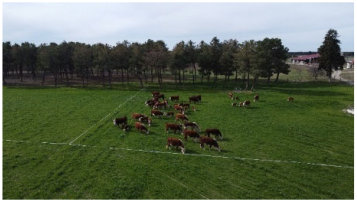  |
| Frequent use of cover crops by adding mulch to the soil [20,80]. In general, minimal tillage is used for weed control in the spring. So that the soil is not completely bare in the summer (in addition to having no living roots), other crops such as sunflowers are planted. This crop has a taproot that helps loosen the deep layers, or what is known as the “plow pan.” | 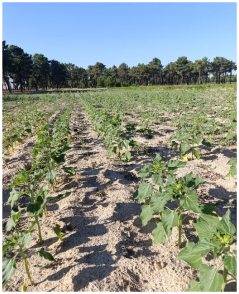 |
| Microsilo. At Kerbest, silage is used for fodder preservation, with the main objective of maintaining the original nutritional value of the fodder, minimizing losses, and preventing the formation of toxic products that could harm the animals’ health [81,82]. |  |
| The aim is to carry out minimal tillage operations, thereby reducing soil disturbance and improving nutrient distribution. This helps protect and improve soil structure and retain much-needed water during dry summer periods, but, above all, it promotes carbon retention. To this end, efforts are made to minimize tillage and reduce traffic, reducing the number of plow passes or agricultural machinery in general, while maintaining surface organic amendments [17,44,48,57,78,83,84,85,86]. |  |
| Help reduce the use of chemical fertilizers through livestock farming, as the manure produced daily benefits the soil. In addition, crop residues act as a true natural fertilizer (nutrients), while protecting and promoting biodiversity. At Kerbest, chemical and synthetic inputs have been eliminated and replaced with organic fertilizers [5,84,86]. |  |
| Avoid poor grazing practices, as these lead to soil compaction and reduced infiltration rates, which exacerbates the availability of soil water for plants. Promote grazing rotation to maintain or restore soil function and resilience, thereby minimizing both soil erosion and nutrient loss [18,87,88,89,90]. Rotational grazing is carried out on a daily basis, consisting of choosing the right time for livestock to graze on a specific plot of land based on the regrowth of the grass and the needs and welfare of the animals. Kerbest promotes the preservation of the biological life system of the soil by adopting sustainable agricultural practices that involve increasing soil organic matter, protecting it from erosion, and promoting biodiversity through crop rotation. This image shows a mobile drinking trough that helps control livestock management. | 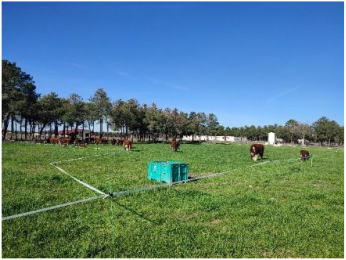 |
| Prioritize the use of animal manure over synthetic fertilizers. In practice, slurry and pig manure are primarily applied. Indeed, in plots with very low organic matter levels, composted manure is added to increase the organic matter level and thus improve water retention, cation exchange capacity, soil structure, and fluffiness. The compost is generated on pig farms (owned by Kerbest) located in the same area, thus promoting a circular economy. The process consists of taking the solid fraction of the slurry, which is mechanically separated, and mixing it with straw litter manure. This solid fraction contains most of the organic matter and a small portion of the nitrogen [24,43,91]. | 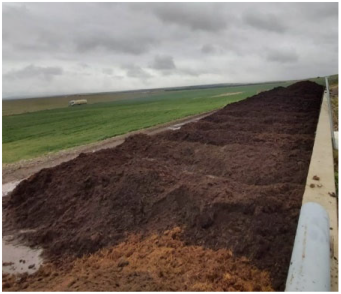  |
| An area with pine trees, sown with local rye, spreading the seed with a fertilizer spreader. Once the entire soil is covered with seed, cows are brought in to move the soil with their hooves to bury the seed, with unifeed carts distributed throughout the different areas each day. |  |
| Keep the soil covered at all times, eliminating spatial and temporal events of bare soil [17,57,78,83,84,85,86]. When crops such as ryegrass are in the stem elongation phase and before heading (the optimal time for grazing), the cows are brought in to graze, moving them with electric fencing each day. By grazing before heading, the crop regrows. This cycle is repeated three times, from February to June, so they have been able to eat it three times, in addition to fertilizing the area with their manure. | 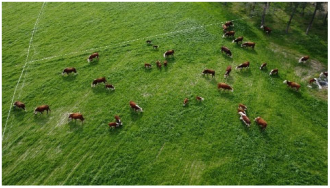 |
| One of the tasks carried out is to quantify production and estimate consumption per cow [17,84,85,86]. Specifically, a 10-hectare plot planted with ryegrass is studied. The photo shows a 0.25 m2 square, where the forage produced is calculated by cutting and weighing (2.4 kg/m2). Each cow eats around 10% of its weight daily, which is equivalent to about 45 kg per cow. For 39 cows (those that graze in this area), 731 m2 is needed daily (39 cows × 45 kg = 1755 kg of daily feed/2.4 kg = 731 m2). | 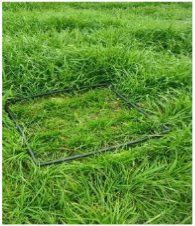  |
| Respect the environment and the natural surroundings of the area, which has high ecological value, especially due to its proximity to El Oso lagoon, which is of great importance for birdlife. This contributes to the protection of wetlands [91] by maintaining adequate water flow. Specifically, avoid filling, burning, introducing exotic species, etc., within semi-lagoon areas such as the one observed, as they tend to dry out, at least superficially, during dry summer periods. |   |
6. Conclusions
Author Contributions
Funding
Institutional Review Board Statement
Informed Consent Statement
Data Availability Statement
Conflicts of Interest
References
- Ritchie, H.; Roser, M. Land Use. Our World in Data. 2013. Available online: https://ourworldindata.org/land (accessed on 5 July 2025).
- Teague, R.; Barnes, M. Grazing management that regenerates ecosystem function and grazing land livelihoods. Afr. J. Range Forage Sci. 2017, 34, 77–86. [Google Scholar] [CrossRef]
- Giller, K.E.; Hijbeek, R.; Andersson, J.A.; Sumberg, J. Regenerative Agriculture: An agronomic perspective. Outlook Agric. 2021, 50, 13–25. [Google Scholar] [CrossRef] [PubMed]
- Jiménez-Ballesta, R. Introducción a la Contaminación de Suelos; Ediciones Mundi-Prensa: Madrid, Spain, 2017; ISBN 978-84-8476-789-3. [Google Scholar]
- Gosnell, H.; Gill, N.; Voyer, M. Transformational adaptation on the farm: Processes of change and persistence in transitions to ‘climate-smart’ regenerative agriculture. Glob. Environ. Change 2019, 59, 101965. [Google Scholar]
- Luján-Soto, R.; Cuéllar-Padilla, M.; de Vente, J. Participatory selection of soil quality indicators for monitoring the impacts of regenerative agriculture on ecosystem services. Ecosyst. Serv. 2020, 45, 101157. [Google Scholar] [CrossRef]
- Schreefel, L.; Schulte, R.P.O.; de Boer, I.J.M.; Schrijver, A.P.; van Zanten, H.H.E. Regenerative Agriculture—The Soil Is the Base. Glob. Food Secur. 2020, 26, 100404. [Google Scholar]
- Wratten, S.D.; Shields, M.W.; González-Chang, M. Prospects for regenerative agriculture in Chile. Agro Sur 2019, 47, 1–6. [Google Scholar] [CrossRef]
- Luján-Soto, R.; Martínez-Mena, M.; Cuéllar-Padilla, M.; de Vente, J. Restoring soil quality of woody agroecosystems in Mediterranean drylands through regenerative agriculture. Agric. Ecosyst. Environ. 2021, 306, 107191. [Google Scholar] [CrossRef]
- Dutta, A.; Bhattacharyya, R.; Jiménez-Ballesta, R.; Dey, A.; Saha, N.D.; Kumar, S.; Nath, C.P.; Prakash, V.; Jatav, S.S.; Patra, A. Conventional and Zero Tillage with Residue Management in Rice–Wheat System in the Indo-Gangetic Plains: Impact on Thermal Sensitivity of Soil Organic Carbon Respiration and Enzyme Activity. Int. J. Environ. Res. Public Health 2023, 20, 810. [Google Scholar]
- Alvarez-Castellanos, M.P.; Escudero-Campos, L.; Mongil-Manso, J.; San Jose, F.J.; Jiménez-Sánchez, A.; Jiménez-Ballesta, R. Organic Carbon Storage in Waterlogging Soils in Ávila, Spain: A Traditional Agrosilvopastoral Region. Land 2024, 13, 1630. [Google Scholar] [CrossRef]
- Colley, T.A.; Olsen, S.I.; Birkved, M.; Hauschild, M.Z. Delta Life Cycle Assessment of Regenerative Agriculture in a Sheep Farming System. Integr. Environ. Assess. Manag. 2020, 16, 282–290. [Google Scholar]
- Duncan, T.; Falloon, B. Case Study: Taranaki Farm Regenerative Agriculture. Pathways to Integrated Ecological Farming. In Land Restoration; Elsevier: Amsterdam, The Netherlands, 2016; p. 17. [Google Scholar]
- Elevitch, C.R.; Mazaroli, D.N.; Ragone, D. Agroforestry Standards for Regenerative Agriculture. Sustainability 2018, 10, 3337. [Google Scholar] [CrossRef]
- Hawkin, P. Regenerative Agriculture, 2019. | Drawdown [WWW Document]. Available online: https://www.drawdown.org/solutions/food/regenerative-agriculture (accessed on 29 April 2019).
- Hodbod, J.; Barreteau, O.; Allen, C.; Ele Magda, D. Managing adaptively for multifunctionality in agricultural systems. J. Environ. Manag. 2016, 183, 379–388. [Google Scholar] [CrossRef]
- LaCanne, C.E.; Lundgren, J.G. Regenerative agriculture: Merging farming and natural resource conservation profitably. PeerJ 2018, 6, e4428. [Google Scholar] [CrossRef] [PubMed]
- Newton, P.; Civita, N.; Frankel-Goldwater, L.; Bartel, K.; Johns, C. What Is Regenerative Agriculture? A Review of Scholar and Practitioner Definitions Based on Processes and Outcomes. Front. Sustain. Food Syst. 2020, 4, 577723. [Google Scholar] [CrossRef]
- Rhodes, C.J. Feeding and healing the world: Through regenerative agriculture and permaculture. Sci. Prog. 2012, 95, 345–446. [Google Scholar] [CrossRef]
- Rodale Institute. Regenerative Organic Agriculture and Climate Change: A Down-to-Earth Solution to Global Warming; Rodale Institute: Kutztown, PA, USA, 2014; Available online: https://rodaleinstitute.org/wp-content/uploads/rodale-white-paper.pdf (accessed on 25 July 2025).
- Shelef, O.; Weisberg, P.J.; Provenza, F.D. The Value of Native Plants and Local Production in an Era of Global Agriculture. Front. Plant Sci. 2017, 8, 2069. [Google Scholar] [CrossRef]
- Strong, G. Regenerative agriculture: The case for dialogue with nature. In Biodiversity: Integrating Conservation and Production: Case Studies from Australian Farms, Forests and Fisheries; Lefroy, T., Bailey, K., Unwin, G., Norton, T., Eds.; CSIRO Publishing: Collingwood, Australia, 2008; p. 13. [Google Scholar]
- Teague, W.R. Forages and Pastures Symposium: Cover Crops in Livestock Production: Whole-System Approach: Managing grazing to restore soil health and farm livelihoods. J. Anim. Sci. 2018, 96, 1519–1530. [Google Scholar] [CrossRef]
- Pellejero, G.; Rodríguez, R.; Tellería, M.; Gallego, L.; Aschkar, G.; Garcia-Navarro, F.J.; Jiménez-Ballesta, R. Organic fertilization enhances the crop yield and quality of zapallo tetsukabuto. Sci. Hortic. 2024, 338, 113766. [Google Scholar] [CrossRef]
- Rodale, R. Breaking New Ground—The Search for a Sustainable Agriculture. Futurist 1983, 1, 15–20. [Google Scholar]
- Yantes, A.M.; Reed, S.P.; Yang, A.M.; Montgomery, R.A. Oak savanna vegetation response to layered restoration approaches: Thinning, burning, and grazing. For. Ecol. Manag. 2023, 537, 120931. [Google Scholar] [CrossRef]
- Marchetto, S.; Wolf, T.M.; Larkin, D.J. The effectiveness of using targeted grazing for vegetation management: A meta-analysis. Restor. Ecol. 2021, 29, e13422. [Google Scholar] [CrossRef]
- Yantes, A.M.; Solberg, K.L.; Montgomery, R.A. Targeted cattle grazing for shrub control in woody-encroached oak savannas. Restor. Ecol. 2025, 33, e14368. [Google Scholar] [CrossRef]
- Bassett, T.J.; Landis, D.A.; Brudvig, L.A. Effects of experimental prescribed fire and tree thinning on oak savanna understory plant communities and ecosystem structure. For. Ecol. Manag. 2020, 464, 118047. [Google Scholar] [CrossRef]
- Harrington, J.A.; Kathol, E. Responses of shrub midstory and herbaceous layers to managed grazing and fire in a North American savanna (oak woodland) and prairie landscape. Restor. Ecol. 2009, 17, 234–244. [Google Scholar] [CrossRef]
- AEACSV. Agricultura de Conservación. Asociación Española de Agricultura de Conservación Suelos Vivos. 2025. Available online: https://agriculturadeconservacion.org/la-ac-en-el-mundo (accessed on 18 June 2025).
- MAPAMA. Encuesta Nacional de Superficies y Rendimientos. Análisis de las Técnicas de Mantenimiento del Suelo y Métodos de Siembra en España; Ministerio de Agricultura, Pesca y Alimentación: Madrid, Spain, 2015.
- Gordon, E.; Davila, F.; Riedy, C. Transforming landscapes and mindscapes through regenerative agriculture. Agric. Hum. Values 2007, 39, 809–826. [Google Scholar] [CrossRef]
- British Ecological Society. Regenerative Agriculture in the UK: An Ecological Perspective; British Ecological Society: London, UK, 2025; ISBN 978-1-0369-1546-9. Available online: https://www.britishecologicalsociety.org/our-policy-work/ (accessed on 5 July 2025).
- Francis, C.A.; Harwood, R.R.; Parr, J.F. The potential for regenerative agriculture in the developing world. Am. J. Altern. Agric. 1986, 1, 65–74. [Google Scholar] [CrossRef]
- Kamenetzky, M.; Maybury, R.H. Agriculture in harmony with nature. Sci. Public Policy 1989, 16, 73–78. [Google Scholar] [CrossRef]
- Dahlberg, K.A. A transition from agriculture to regenerative food systems. Futures 1994, 26, 170–179. [Google Scholar] [CrossRef]
- Gabel, M. Ho-Ping: A World Scenario for Food Production; World Game Institute: Philadelphia, PA, USA, 1979. [Google Scholar]
- Rodale, R. Learning to Think Regeneratively. Bull. Sci. Technol. Soc. 1986, 6, 6–13. [Google Scholar] [CrossRef]
- Zoveda, F.; Garcia, S.; Pandey, S.; Thomas, G.; Soto, D.; Bianchi, G.; Faures, J.M.; Griffin, J.; Lipper, L.; Vahanen, T.; et al. Building a Common Vision for Sustainable Food and Agriculture; FAO: Rome, Italy, 2014; p. 56. [Google Scholar]
- Lal, R. Regenerative agriculture for food and climate. J. Soil Water Conserv. 2020, 75, 123A–124A. [Google Scholar] [CrossRef]
- Khangura, R.; Ferris, D.; Wagg, C.; Bowyer, J. Regenerative Agriculture—A literature review on the practices and mechanisms used to improve soil health. Sustainability 2023, 15, 2338. [Google Scholar] [CrossRef]
- Rhodes, C.J. The Imperative for Regenerative Agriculture. Sci. Prog. 2017, 100, 80–129. [Google Scholar] [CrossRef] [PubMed]
- Brown, G. Dirt to Soil: One Family’s Journey into Regenerative Agriculture; Chelsea Green: White River Junction, VT, USA, 2018; Available online: https://www.chelseagreen.com/product/dirt-to-soil/ (accessed on 5 July 2025).
- Landers, J.N.; de Freitas, P.L.; de Oliveira, M.C.; da Silva Neto, S.P.; Ralisch, R.; Kueneman, E.A. Next Steps for Conservation Agriculture. Agronomy 2021, 11, 2496. [Google Scholar] [CrossRef]
- Tittonell, P.; El Mujtar, V.; Felix, G.; Kebede, Y.; Laborda, L.; Soto, R.L.; de Vente, J. Regenerative agriculture—Agroecology without politics? Front. Sustain. Food Syst. 2022, 6, 844261. [Google Scholar] [CrossRef]
- Gremmen, B. Regenerative agriculture as a biomimetic technology. Outlook Agric. 2022, 51, 39–45. [Google Scholar] [CrossRef]
- Sherwood, S.; Uphoff, N. Soil health: Research, practice and policy for a more regenerative agriculture. Appl. Soil Ecol. 2000, 15, 85–97. [Google Scholar] [CrossRef]
- Razzaghi, S. Can soil health management enhance carbon sequestration against climate change? In Management of Soil and Plant Health in The Era of Climate Change; Iksad Publications: Ankara, Turkey, 2024; pp. 41–70. [Google Scholar] [CrossRef]
- De Otálora, X.D.; Epelde, L.; Arranz, J.; Garbisu, C.; Ruiz, R.; Mandaluniz, N. Regenerative rotational grazing management of dairy sheep increases springtime grass production and topsoil carbon storage. Ecol. Indic. 2021, 125, 11. [Google Scholar] [CrossRef]
- Schulte, L.A.; Dale, B.E.; Bozzetto, S.; Liebman, M.; Souza, G.M.; Haddad, N.; Richard, T.L.; Basso, B.; Brown, R.C.; Hilbert, J.A. Meeting global challenges with regenerative agriculture producing food and energy. Nat. Sustain. 2022, 5, 384–388. [Google Scholar] [CrossRef]
- Rehberger, E.; West, P.C.; Spillane, C.; McKeown, P.C. What climate and environmental benefits of regenerative agriculture practices? an evidence review. Environ. Commun. Res. 2023, 5, 052001. [Google Scholar] [CrossRef]
- Van Oudenhove, M.; Martínez-Mena, M.; Almagro, M.; Díaz-Pereira, E.; Carrillo, E.; de Vente, J.; Fernández-Soler, C.; Luján-Soto, R.; Boix-Fayos, C. The Impact of Regenerative Agriculture on Provisioning Ecosystem Services: An Example in Southeast Spain. Biol. Life Sci. Forum 2024, 30, 28. [Google Scholar] [CrossRef]
- IGME. Mapa Geológico Nacional a Escala 1:50.000. Hoja 481 (La Nava de Arévalo) y Memoria; IGME: Madrid, Spain, 1982. [Google Scholar]
- Martín-García, L.P. Flora y Vegetación del Término Municipal de El Oso (Ávila). CONAMA 10. 2010. Available online: http://www.conama10.vsf.es/conama10/download/files/CT%202010/40830.pdf (accessed on 16 June 2025).
- Barrera, I.; Carrasco y Salazar, M.A.; Cirujano, S.; Sánchez-Sánchez, J.; Velayos, M. Plantas de la comarca de La Moraña (Ávila, España). Stud. Bot. 1986, 5, 149–153. [Google Scholar]
- Sahu, G.; Das, S. Regenerative Agriculture: Future of Sustainable Food Production. Biot. Res. Today 2014, 2, 745–748. [Google Scholar]
- Restrepo Rivera, J. Manual Práctico El A, B, C de la Agricultura Orgánica y Harina de Rocas; SIMAS: Managua, Nicaragua, 2008; 262p, Available online: https://caminosostenible.org/ (accessed on 4 April 2025).
- Mollison, B. Introducción a La Permacultura; Ten Speed Press: Berekely, CA, USA, 1978; Available online: https://consorcioagroecologico.pe/wp-content/uploads/2021/12/COMPILACION-DE-LIBROS-CAP.pdf (accessed on 4 April 2025).
- CAST. Council for Agricultural Science and Technology. Animal Agriculture and Global Food Supply; Task Force Report 135; CAST: Ames, IA, USA, 1999. [Google Scholar]
- Janzen, H.H. What place for livestock on a re-greening earth? Anim. Feed. Sci. Technol. 2010, 166–167, 783–796. [Google Scholar] [CrossRef]
- Teague, W.R.; Apfelbaum, S.; Lal, R.; Kreuter, U.P.; Rowntree, J.; Davies, C.; Conser, R.; Rasmussen, M.; Hatfield, J.; Wang, T.; et al. The role of ruminants in reducing agriculture’s carbon footprint in North America. J. Soil Water Conserv. 2016, 71, 156–164. [Google Scholar] [CrossRef]
- Baradwal, H.; Ghosh, A.; Singh, A.K.; Jiménez-Ballesta, R.; Yadav, R.K.; Misra, S.; Siddanagouda Sannagoudar, M.; Kumar, S.; Kumar, R.V.; Singh, S.K.; et al. Soil Nutrient Dynamics under Silviculture, Silvipasture and Hortipasture as Alternate Land-Use Systems in Semi-Arid Environment. Forests 2023, 14, 125. [Google Scholar] [CrossRef]
- Sulc, R.M.; Tracy, B.F. Integrated Crop–Livestock Systems in the U.S. Corn Belt. Agron. J. 2007, 99, 335–345. [Google Scholar] [CrossRef]
- Gebru, H. A review on the comparative advantages of intercropping to mono-cropping system. J. Biol. Agric. Healthc. 2015, 5, 1–13. [Google Scholar]
- Busari, M.A.; Kukal, S.S.; Kaur, A.; Bhatt, R.; Dulazi, A.A. Conservation tillage impacts on soil, crop and the environment. Int. Soil Water Conserv. Res. 2015, 3, 119–129. [Google Scholar] [CrossRef]
- Chen, W.; Huang, D.; Liu, N.; Zhang, Y.; Badgery, W.; Wang, X.; Shen, Y. Improved grazing management may increase soil carbon sequestration in temperate steppe. Sci. Rep. 2015, 5, 10892. [Google Scholar] [CrossRef]
- Kaye, J.P.; Quemada, M. Using cover crops to mitigate and adapt to climate change—A review. Agron. Sustain. Dev. 2017, 37, 4. [Google Scholar] [CrossRef]
- Rui, Y.; Jackson, R.D.; Cotrufo, M.F.; Sanford, G.R.; Spiesman, B.J.; Deiss, L.; Culman, S.W.; Liang, C.; Ruark, M.D. Persistent soil carbon enhanced in Mollisols by well-managed grasslands but not annual grain or dairy forage cropping systems. Proc. Natl. Acad. Sci. USA 2022, 119, e2118931119. [Google Scholar] [CrossRef]
- Xu, N.; Bhadha, J.H.; Rabbany, A.; Swanson, S. Soil Health Assessment of Two Regenerative Farming Practices on Sandy Soils. Sustain. Agric. Res. 2019, 8, 61–71. [Google Scholar] [CrossRef]
- Clewell, A.F.; Aronson, J. Ecological Restoration: Principles, Values, and Structure of an Emerging Profession; Island Press: Washington, DC, USA, 2007. [Google Scholar]
- Dunwiddie, P.W.; Bakker, J.D. The future of restoration and management of prairie-oak ecosystems in the Pacific Northwest. Northwest Sci. 2011, 85, 83–92. [Google Scholar] [CrossRef]
- Greipsson, S. Restoration Ecology; Jones and Bartlett Learning: Sudbury, MA, USA, 2011. [Google Scholar]
- Kirkman, L.K.; Coffey, K.L.; Mitchell, R.J.; Moser, E.B. Ground cover recovery patterns and life-history traits: Implications for restoration obstacles and opportunities in a species-rich savanna. J. Ecol. 2004, 92, 409–421. [Google Scholar] [CrossRef]
- Mandle, L.; Bufford, J.L.; Schmidt, I.B.; Daehler, C.C. Woody exotic plant invasions and fire: Reciprocal impacts and consequences for native ecosystems. Biol. Invasions 2011, 13, 1815–1827. [Google Scholar] [CrossRef]
- Ansley, R.J.; Castellano, M.J. Strategies for savanna restoration in the southern Great Plains: Effects of fire and herbicides. Restor. Ecol. 2006, 14, 420–428. [Google Scholar] [CrossRef]
- Dudley, N.; Eufemia, L.; Fleckenstein, M.; Periago, M.E.; Petersen, I.; Timmers, J.F. Grasslands and savannahs in the UN decade on ecosystem restoration. Restor. Ecol. 2020, 28, 1313–1317. [Google Scholar] [CrossRef]
- General Mills. Regenerative Agriculture. 2025. Available online: https://www.generalmills.com/en/Responsibility/Sustainability/Regenerative-agriculture (accessed on 6 August 2025).
- Olaniyan, C.; Ujah, G.; Ogunsola, M.; Afanwoubo, B. Integrating Trees into Agricultural Landscapes: Benefits and Challenges of Agroforestry Systems. Int. J. Agric. Earth Sci. (IJAES) 2024, 10, 94–121. [Google Scholar] [CrossRef]
- Pisciotta, A.; Di Lorenzo, R.; Novara, A.; Laudicina, V.A.; Barone, E.; Santoro, A.; Gristina, L.; Barbagallo, M.G. Cover crop and pruning residue management to reduce nitrogen mineral fertilization in Mediterranean vineyards. Agronomy 2021, 11, 164. [Google Scholar] [CrossRef]
- Bernardes, T.F. Advances in silage sealing. In Advances in Silage Production and Utilization; Da Silva, T., Santos, E.M., Eds.; InTech: Rijeka, Croatia, 2016; Volume 1, pp. 53–62. [Google Scholar]
- Bernardes, T.F.; Daniel, J.L.P.; Adesogan, A.T.; McAllister, T.A.; Drouin, P.; Nussio, L.G.; Huhtanen, P.; Tremblay, G.F.; Bélanger, G.; Cai, Y. Silage review: Unique challenges of silages made in hot and cold regions. J. Dairy Sci. 2018, 101, 4001–4019. [Google Scholar] [CrossRef]
- Jug, D.; Jug, I.; Brozović, B.; Šeremešić, S.; Dolijanović, Ž.; Zsembeli, J.; Ujj, A.; Marjanovic, J.; Smutny, V.; Dušková, S.; et al. Conservation Soil Tillage: Bridging Science and Farmer Expectations—An Overview from Southern to Northern Europe. Agriculture 2025, 15, 260. [Google Scholar] [CrossRef]
- Brown, G. Regeneration of Our Lands: A Producer’s Perspective. 2016. TEDxGrandForks. Available online: https://www.youtube.com/watch?v=QfTZ0rnowcc (accessed on 6 August 2025).
- California State University. What is Regenerative Agriculture? 2017. Available online: https://www.csuchico.edu/regenerativeagriculture/_assets/documents/ra101-reg-Sagdefinition.pdf (accessed on 6 August 2025).
- Drawdown. Drawdown: The Most Comprehensive Plan ever Proposed to Reverse Global Warming. Penguin Books. [An Online Version also Provides Technical Summaries]. 2017. Available online: https://www.drawdown.org/solutions/food (accessed on 5 August 2025).
- Ritter, W.F. Reducing impacts of non-point source pollution from agriculture. J. Environ. Sci. Health 1988, 23, 645–667. [Google Scholar]
- Sovell, L.A.; Vondracek, B.; Frost, J.A.; Mumford, K.G. Impacts of rotational grazing and riparian buffers on physio-chemical and biological characteristics of Southeastern Minnesota, USA, Streams. Environ. Manag. 2000, 26, 629–641. [Google Scholar] [CrossRef] [PubMed]
- Teague, W.R.; Dowhower, S.L.; Baker, S.A.; Haile, N.; DeLaune, P.; Conover, D. Grazing management impacts on vegetation, soil biota and soil chemical, physical and hydrological properties in tall grass prairie. Agric. Ecosyst. Environ. 2011, 141, 310–322. [Google Scholar] [CrossRef]
- Havstad, K.M.; Peters, D.P.C.; Skaggs, R.; Brown, J.; Bestelmeyer, B.; Fredrickson, E.; Herrick, J.; Wright, J. Ecological services to and from rangelands of the United States. Ecol. Econ. 2007, 64, 261–268. [Google Scholar] [CrossRef]
- Pearson, C.J. Regenerative, Semiclosed Systems: A Priority for Twenty-First-Century Agriculture. BioScience 2007, 57, 409–418. [Google Scholar] [CrossRef]
- Al-Kaisi, M.M.; Lal, R. Aligning science and policy of regenerative agriculture. Soil Sci. Soc. Am. J. 2020, 84, 1808–1820. [Google Scholar] [CrossRef]
- Burns, E.A. Research Needed: Business Opportunities in the Farmer-led Regenerative Agriculture Movement in New Zealand. N. Z. J. Appl. Bus. Res. 2022, 18, 1–14. [Google Scholar] [CrossRef]
- Dudek, M.; Rosa, A. Regenerative Agriculture as a Sustainable System of Food Production: Concepts, Conditions, Perceptions and Initial Implementations in Poland, Czechia and Slovakia. Sustainability 2023, 15, 15721. [Google Scholar] [CrossRef]
- Jiménez-Ballesta, R.; San José, F.J.; Mongil-Manso, J.; Escudero-Campos, L.; Álvarez-Castellanos, M.P. Properties of Waterlogged Soils Developed on Arkose and Aeolian Sands in an Agro-Silvopastoral System. Eur. J. Soil Sci. 2025, 76, e70055. [Google Scholar] [CrossRef]


| It helps to conserve and restore soils by improving their physical, chemical, and biological quality. This is achieved by reducing compaction through reduced use of heavy machinery, increasing organic matter content, improving soil structure, and increasing nutrients (increased fertility). |
| It improves water infiltration and retention and reduces erosion and destruction of fertile soil. This makes farmland more resilient to inclement weather. |
| It reduces crop sensitivity and improves production. |
| It boosts pollinators and increases biodiversity overall, which also enhances the landscape’s appearance. |
| It mitigates climate change thanks to the fixation of organic carbon in soils, i.e., a decrease in atmospheric CO2 concentrations. |
| It eliminates waste from conventional agriculture by avoiding the use of plastics, synthetic chemical fertilizers, pesticides, and herbicides. |
| It increases crop productivity and contributes to higher nutritional value in food. |
| It helps conserve natural habitats and biodiversity across landscapes. |
| Principles | Explanation |
|---|---|
| Silvopastoralism | Maintenance of trees as a “secondary crop,” providing shade for livestock while capturing and retaining rainfall. In addition, tree roots improve soil health and forage nutrient quality. |
| Livestock movement | Daily cattle movements with the aim of grazing the plants at their optimal grazing stage. After grazing, the land is left to rest, allowing it to regrow until it reaches its optimal grazing stage again. |
| Livestock diversity | Coexistence of different types of livestock (Wagyu and Hereford cows, goats, horses), as diversity provides benefits in itself. |
| Cover crops | Cover crops reduce erosion, fix atmospheric nitrogen, reduce nitrogen leaching, improve soil health, and alleviate soil surface warming. |
| Minimal tillage | By reducing excavation, removal, and turning of soil, carbon emissions are reduced, thereby increasing soil carbon while decreasing erosion and conserving soil moisture. |
| Crop diversity | Diversity is considered a biological resource, but also an economic buffer. Crop rotation reduces the use of herbicides and, therefore, the contamination of surface and groundwater. |
| Minimal use of pesticides | The aim is to minimize their use, given that the main problems of water pollution. |
Disclaimer/Publisher’s Note: The statements, opinions and data contained in all publications are solely those of the individual author(s) and contributor(s) and not of MDPI and/or the editor(s). MDPI and/or the editor(s) disclaim responsibility for any injury to people or property resulting from any ideas, methods, instructions or products referred to in the content. |
© 2025 by the authors. Licensee MDPI, Basel, Switzerland. This article is an open access article distributed under the terms and conditions of the Creative Commons Attribution (CC BY) license (https://creativecommons.org/licenses/by/4.0/).
Share and Cite
Jiménez-Ballesta, R.; Mongil-Manso, J.; Jiménez-Sánchez, A. Application of Regenerative Agriculture: A Review and Case Study in an Agrosilvopastoral Region. Sustainability 2025, 17, 9066. https://doi.org/10.3390/su17209066
Jiménez-Ballesta R, Mongil-Manso J, Jiménez-Sánchez A. Application of Regenerative Agriculture: A Review and Case Study in an Agrosilvopastoral Region. Sustainability. 2025; 17(20):9066. https://doi.org/10.3390/su17209066
Chicago/Turabian StyleJiménez-Ballesta, Raimundo, Jorge Mongil-Manso, and Adrián Jiménez-Sánchez. 2025. "Application of Regenerative Agriculture: A Review and Case Study in an Agrosilvopastoral Region" Sustainability 17, no. 20: 9066. https://doi.org/10.3390/su17209066
APA StyleJiménez-Ballesta, R., Mongil-Manso, J., & Jiménez-Sánchez, A. (2025). Application of Regenerative Agriculture: A Review and Case Study in an Agrosilvopastoral Region. Sustainability, 17(20), 9066. https://doi.org/10.3390/su17209066








